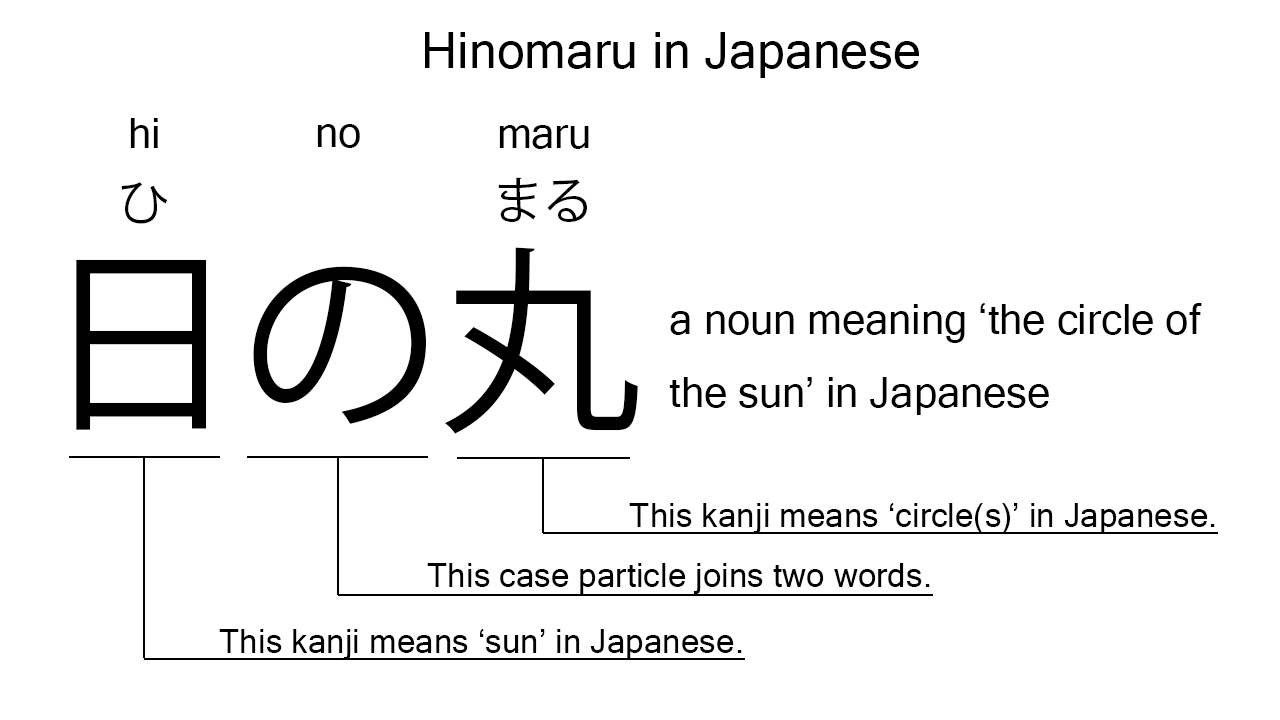What does “hinomaru” mean in Japanese?
Native speakers say “hinomaru” to mean ‘the circle of the sun’ in Japanese. Perhaps, some Japanese learners know this word as it is sometimes used in Japanese movies, novels, manga, anime, and the like. In this blog post, however, I will explain this word in detail based on its grammatical components. And also, I will explain how to use it through example sentences. My explanations would help Japanese learners understand “hinomaru” more clearly. Then, let’s get started!
Contents
Definition and meanings of “hinomaru”
Let me start with the definition and meanings of “hinomaru”.
- hinomaru – 日の丸 (ひのまる) : a noun meaning ‘the circle of the sun’ or sometimes ‘the national flag of Japan’ in Japanese.
Japanese native speakers use this noun to mean ‘the circle of the sun’ in Japanese. It’s also worth mentioning here that they sometimes use this to refer to the red circle on the national flag of Japan or the flag itself.
The definition and meanings are not that difficult, I think. To understand this noun more clearly, however, let me explain its grammatical components in detail, one by one.
What does “hinomaru” literally mean?
“Hinomaru” consists of the following three characters:
- 日 : a kanji character used to mean ‘day’, ‘sun’, or ‘sunlight’ in Japanese.
- の : a case particle joining two nouns. Normally, the first one can work as a modifier to describe the second.
- 丸 : a kanji character used to mean ‘circle’ in Japanese.
From these three components, we can understand that the formed noun literally means “sun’s circle” in Japanese. This literal interpretation is very close to the actual meanings.

When we meet new Japanese words, we should check their grammatical components in detail to understand their meanings clearly and deeply. In many cases, components tell us a lot about the meanings of the words they form. Actually, here, we could get the better understanding of “hinomaru” through the detailed check above.
So far, I’ve explained the definition and meanings of “hinomaru” together with its grammatical components. Then, let me explain how to use it through the example sentences below.
Example #1: how to say “the circle of the sun” in Japanese
hinomaru wa nippon no kokki desu – 日の丸は日本の国旗です (ひのまるはにっぽんのこっきです)
The circle of the sun is the national flag of Japan.
Below are the new words used in the example sentence.
- wa – は : a binding particle working as a case marker or topic marker. In the example, this works after “hinomaru” to make the subject in the sentence.
- nippon – 日本 (にっぽん) : a noun meaning ‘Japan’ in Japanese.
- no – の : the same as used in “hinomaru”. In the example, this works to join “nippon” and “kokki”. The formed phrase literally means ‘the national flag of Japan’ in Japanese. Word orders in Japanese and English are different, but the role of this case particle is very similar to that of the English preposition, “of”.
- kokki – 国旗 (こっき) : a noun meaning ‘national flag’ in Japanese. This can also work as plural. Learn more about Japanese plural.
- desu – です : an auxiliary verb used after a noun or adjective to make it polite. Probably, this is well known as a part of Japanese desu form. In the example, this is used after “nippon no kokki” to make it sound polite.
This is a typical usage of “hinomaru”. In this example, it works together with the binding particle, “wa”, to become the subject in the sentence.
Example #2: another usage of “hinomaru”
watashi wa hinomaru no dezain ga suki desu – 私は日の丸のデザインが好きです (わたしはひのまるのでざいんがすきです)
I love the design of the circle of the sun.
Below are the new words used in the example sentence.
- watashi – 私 (わたし) : a pronoun meaning ‘I’ in Japanese. In the example, this works together with “wa” to become the subject in the sentence.
- dezain – デザイン (でざいん) : a noun meaning ‘design’ in Japanese. This can also work as plural.
- ga – が : a case particle used to make the subject word or the object word in a sentence. In the example, this is used after “hinomaru no dezain” to make the object in the sentence.
- suki – 好き (すき) : the stem part of the na-adjective, “sukina”, which means ‘favorite’ in Japanese. Native speakers, however, often use this as an individual word to mean ‘to like’ or ‘to love’ in Japanese. In the example, this is used to mean ‘to love’.
This is another typical usage of “hinomaru”. In this example, it works as a part of the noun phrase, “hinomaru no dezain”, which literally means ‘the design of the circle of the sun’ in Japanese. When we want to say “the circle of the sun” or “the national flag of Japan” in Japanese, this noun is always a very good option.
Summary
In this blog post, I’ve explained the definition and meanings of “hinomaru” in detail based on its grammatical components. And also, I’ve explained how to use it through the example sentences. Let me summarize them as follows.
- hinomaru – 日の丸 (ひのまる) : a noun meaning ‘the circle of the sun’ in Japanese. It’s also worth mentioning here that Japanese native speakers sometimes use this noun to refer to the red circle on the national flag of Japan or the flag itself. These three characters literally mean “sun’s circle” in Japanese. This literal interpretation is very close to the actual meanings.
Hope my explanations are understandable and helpful for Japanese learners.